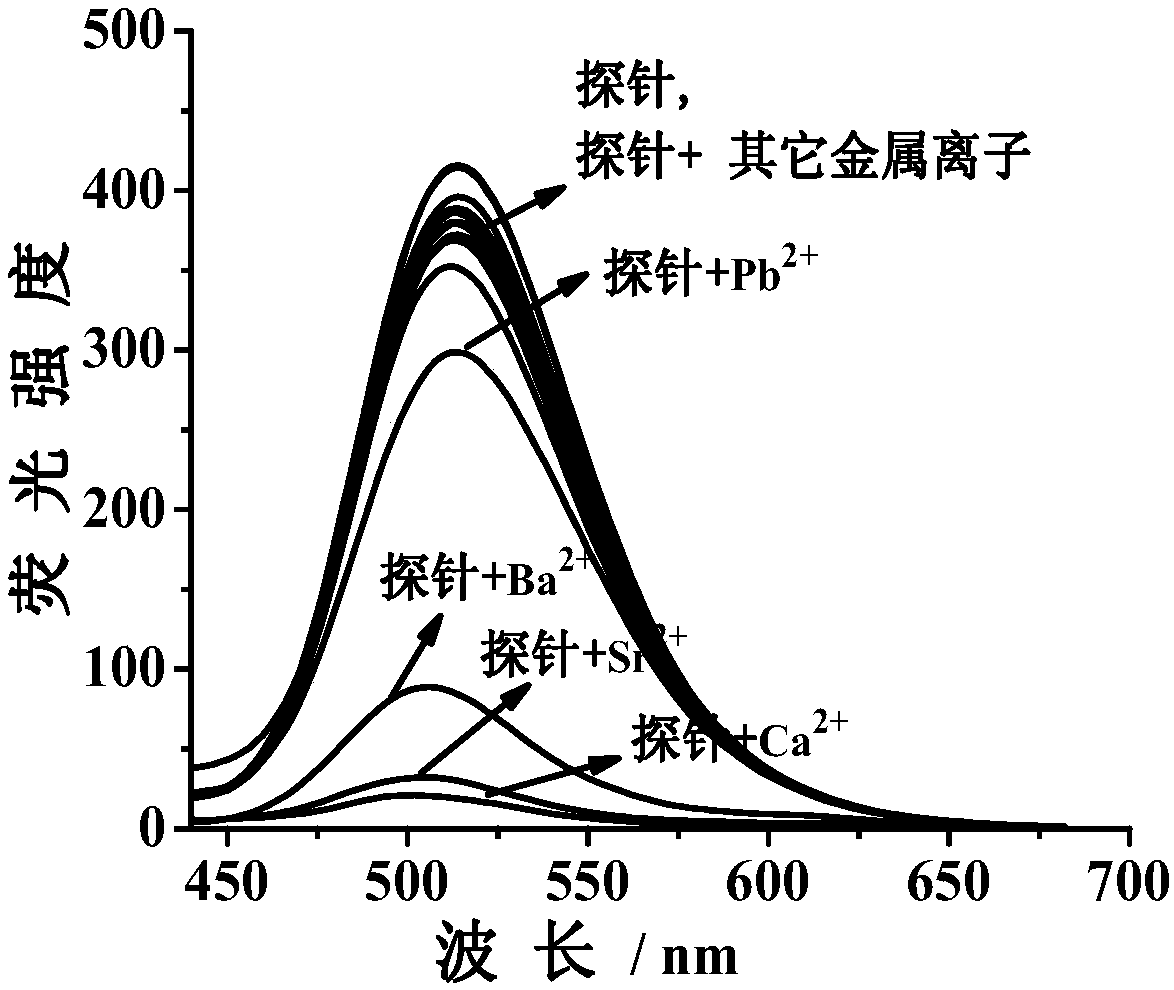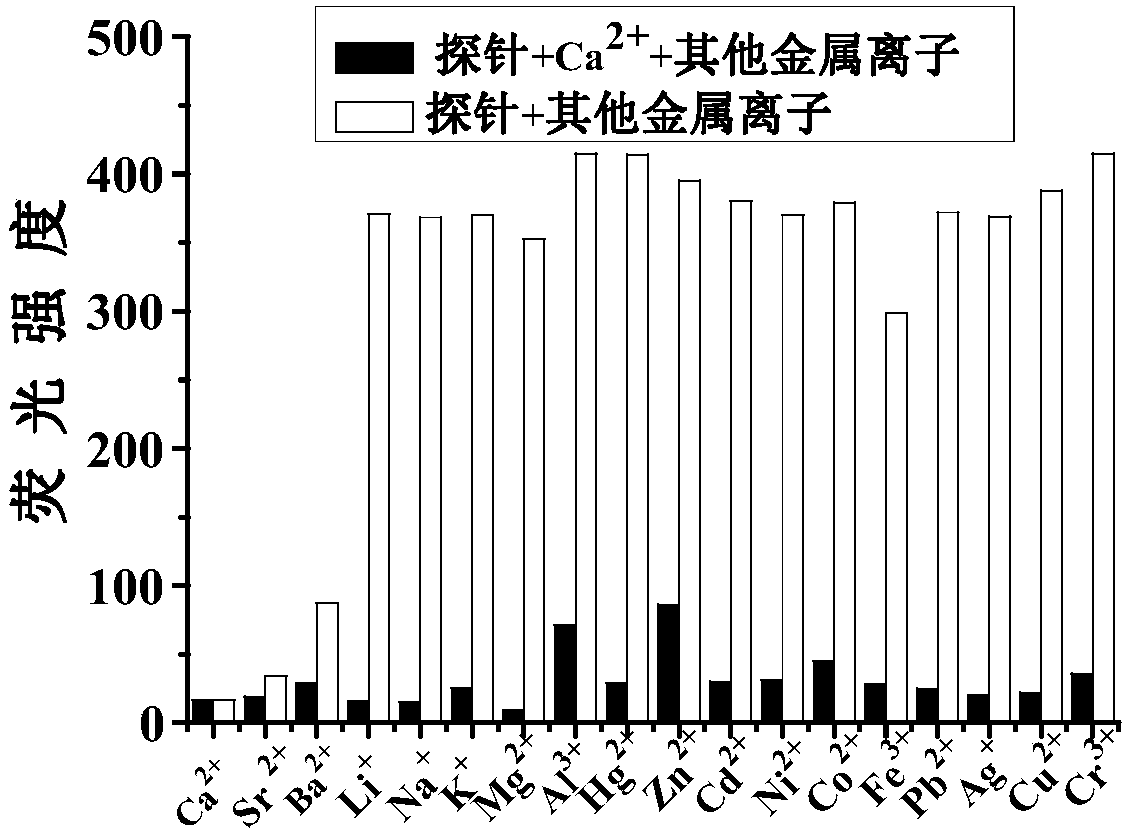Method for detecting trace amounts of Ca<2+>, Sr<2+> and Ba<2+> in active cancer cells through single-channel fluorescence imaging
A fluorescence imaging, single-channel technology, used in measurement devices, fluorescence/phosphorescence, material analysis by optical means, etc., can solve problems such as poor selectivity, inconvenient detection, and inability to achieve efficient detection, and achieve convenient monitoring and high sensitivity. , the effect of less interference
- Summary
- Abstract
- Description
- Claims
- Application Information
AI Technical Summary
Problems solved by technology
Method used
Image
Examples
Embodiment 1
[0054] 1. Probe preparation:
[0055] The chemical structural formula of the probe is:
[0056]
[0057] Its synthetic route is as follows:
[0058]
[0059] The specific preparation method is:
[0060] ① Preparation of Intermediate 1:
[0061] Take 100 grams (0.67mol) of p-tert-butylphenol, add it to a 1000ml three-necked round-bottomed flask, then add 1.55g (33.75mmol) sodium hydroxide and 80ml of 37% formaldehyde solution in sequence, and blow out more than 90% of it under nitrogen flow Most of the water, heated to 115°C (110-120°C), mechanically stirred for 2h, stopped the reaction, cooled to room temperature, poured 500ml of 85°C diphenyl ether into it, and continued to stir, the mixture in the flask Heating to reflux temperature, after reacting for 3 hours, stop the reaction, cool to room temperature, add 2000ml ethyl acetate into the flask, stir until white precipitate precipitates out, let stand, suction filter, and successively use 50ml ethyl acetate, 50ml ac...
Embodiment 2
[0070] Embodiment 2. The preparation of reagent:
[0071] (1) Preparation of probe solution: Weigh 10.3 mg of probe (prepared by the above method), dissolve it in N,N-dimethylformamide, and prepare 10 mL of a solution with a concentration of 1 mM.
[0072] (2)Ca 2+ Preparation of ion stock solution: Weigh 0.3110 g of calcium perchlorate, dissolve it in ultrapure water, prepare 50 mL of a solution with a concentration of 20 mM, and then dilute to the required concentration with ultrapure water.
[0073] (3)Sr 2+ Preparation of ion stock solution: Weigh 0.3946g of strontium perchlorate, dissolve it in ultrapure water, prepare 50mL of solutions with a concentration of 20mM, and then dilute to the required concentration with ultrapure water.
[0074] (4) Ba 2+ Preparation of ion stock solution: Weigh 0.3903g of barium perchlorate, dissolve it in ultrapure water, prepare 50mL of solutions with a concentration of 20mM, and then dilute to the required concentration with ultrapure ...
Embodiment 3
[0082] Embodiment 3: Fluorescence spectrometry detects Ca 2+ 、Sr 2+ 、Ba 2+
[0083] Add the probe (1mM, 100μL) into a 10mL volumetric flask, dilute it with N,N-dimethylformamide / water, so that the composition of the probe solution is N,N-dimethylformamide with a volume ratio of 9 / 1 Amide / water solution, shake well. Add about 3ml into a 1cm cuvette, and measure the fluorescence spectrum with 405nm as the fluorescence excitation wavelength.
[0084] In N,N-dimethylformamide / water solution with a volume ratio of 9 / 1, the probe solution with a concentration of 10 μM has fluorescence emission at a wavelength of 510 nm. Add 200 μM metal ion Li + , Na + , K + , Mg 2+ , Ca 2+ , Ba 2+ , Hg 2+ ,Sr 2+ , Zn 2+ , Cd 2+ , Ni 2+ ,Co 2+ , Pb 2+ , Fe 3+ , Cr 3+ , Ag 2+ , Cu 2+ , no obvious change in the fluorescence spectrum was observed, only the addition of 200 μM Ca 2+ 、Sr 2+ 、Ba 2+ Significantly reduce the fluorescence peak of the probe at 510nm (see figure 1 ).
...
PUM
 Login to View More
Login to View More Abstract
Description
Claims
Application Information
 Login to View More
Login to View More - R&D
- Intellectual Property
- Life Sciences
- Materials
- Tech Scout
- Unparalleled Data Quality
- Higher Quality Content
- 60% Fewer Hallucinations
Browse by: Latest US Patents, China's latest patents, Technical Efficacy Thesaurus, Application Domain, Technology Topic, Popular Technical Reports.
© 2025 PatSnap. All rights reserved.Legal|Privacy policy|Modern Slavery Act Transparency Statement|Sitemap|About US| Contact US: help@patsnap.com



